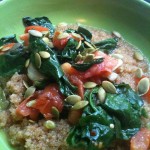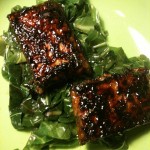Another recipe adaptation, yay! This one used to be a lamb ragout, and it’s from the same Spanish cookbook as the lentil recipe. It continues my love affair with tempeh. Nomz. This was was a pleasant surprise and success! You could use tofu, too, but probably would want to freeze it, thaw it, and press it before cooking.
Ingredients:
- 250-300g tempeh, cut into bite-sized pieces (if not fresh, steam for 15 min first)
- 1 Tbsp worcestershire sauce (or veg equivalent)
- 1 Tbsp Bragg’s Liquid Aminos (use tamari if unavailable)
- 1kg-1.2kg of small white potatoes, scrubbed, trimmed and quartered or cut into bite-sized pieces — peel only if necessary
- 250g carrots, sliced
- 250mL white wine (you could try with red, too)
- 1 medium onion, chopped
- 3/4 cup dried shiitake mushrooms (use cremini for a different flavour!)
- 1 Tbsp flour
- 4 cloves garlic, minced and separated
- 1 bunch parsley, chopped coarsely and separated
- 1 bay leaf
- 3 tablespoons extra virgin olive oil, separated
- 1-2 tsp salt, to taste
- Water
Preparation:
Season the tempeh with the worcestershire sauce and liquid aminos, as well as with the 1 clove of chopped garlic. Leave in a non-reactive dish to marinate for 20-30 minutes or more. When ready, heat 1 Tbsp of olive oil in a frying pan over medium heat and brown the tempeh. Remove and put in a large pot or casserole pot. Add the sliced carrots.
Add 1-2 cups boiling water to the mushrooms. Let them soak 15-20 minutes.
Fry the chopped onion in the same oil used to brown the tempeh. Add a splash more of oil if needed. When onion is brown, remove from heat and add to the casserole pot.
Put 1 Tbsp of garlic in a mortar and crush it with half of the chopped parsley. Put the parsley-garlic mixture in a separate small bowl and mix with the white wine. Pour the entire mixture — wine, garlic, parsley — into the casserole pot with the onions, carrots, and tempeh. Cover and cook over medium heat for 5-7 minutes, stirring occasionally.
Season the potatoes with the rest of the chopped garlic. Sauté them in another tablespoon of oil over medium heat. When lightly browned, remove them with a slotted spoon and add them to the tempeh-carrot mixture, which should still be on medium heat.
In the same frying pan used for the potatoes, sprinkle the flour and stir over low heat until it turns golden brown. Add water and stir, cooking for a few minutes. When slightly thickened, remove from heat and add to the casserole pot.
Check the mushrooms and slice coarsely. Add them to the casserole pot. Add the mushroom soaking water to the casserole pot, too, and stir. Add water to cover all the vegetables, and cook 15 minutes uncovered on medium-low heat. Stir occasionally.
After 15 minutes, check for salt, and add as necessary. Cook for another 5 minutes or more, until potatoes are fork-tender. Serve piping hot. Garnish with remaining chopped parsley.




